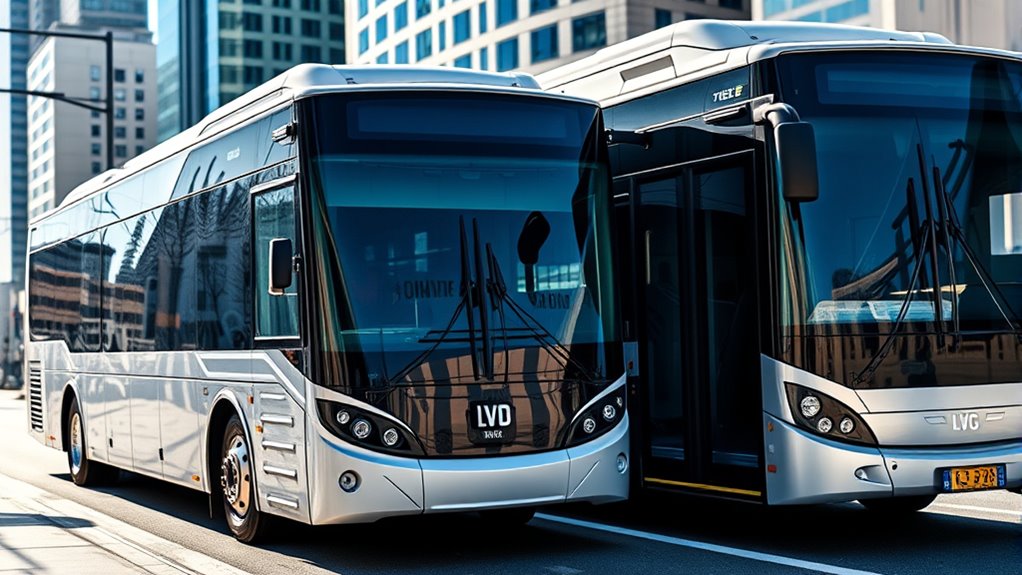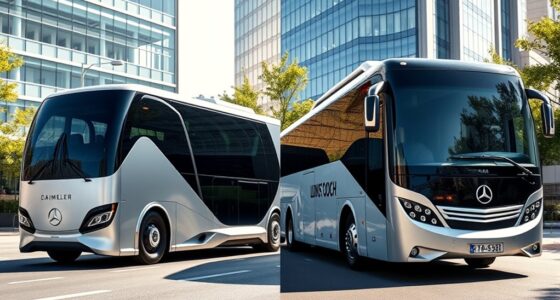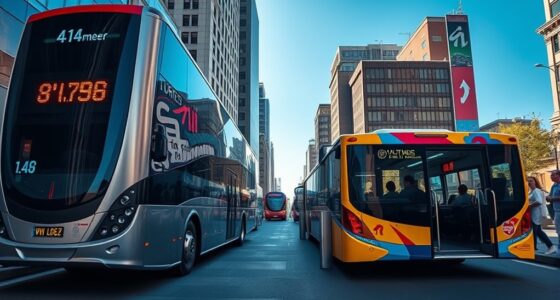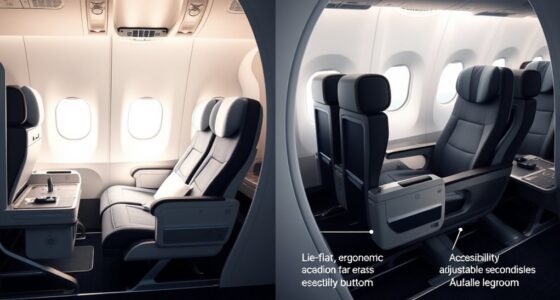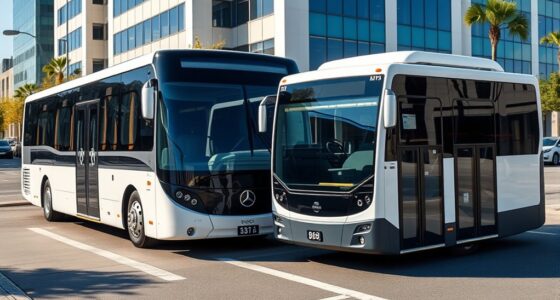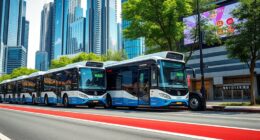In comparing single‑motor and dual‑motor electric buses, the dual‑motor setup delivers more power, better traction, and faster acceleration, which is great for demanding routes. However, it comes with higher costs, more complex maintenance, and increased wear on parts. On the other hand, a single‑motor bus is simpler, more affordable, and easier to manage, making it ideal for straightforward operations. To discover how these differences affect your fleet, keep exploring the details below.
Key Takeaways
- Dual-motor buses deliver higher power and faster acceleration compared to single-motor setups.
- Single-motor buses are more efficient overall, with simpler systems leading to lower energy losses.
- Dual-motor configurations improve traction, especially in challenging terrains or demanding conditions.
- Single-motor designs have lower energy consumption due to fewer components and reduced complexity.
- The increased power of dual-motor buses often results in higher energy demands and potentially lower overall efficiency.
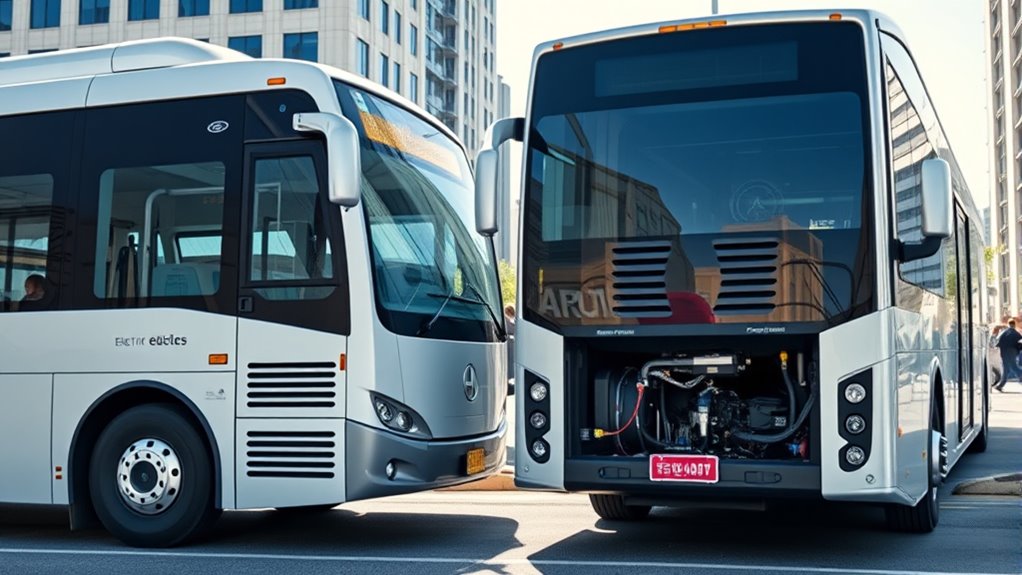
When choosing between single-motor and dual-motor electric buses, understanding their differences can markedly impact performance and efficiency. One of the key factors to weigh is how each configuration affects battery management. With a single-motor setup, the power flow is centralized, which simplifies battery management since the system distributes workload across fewer components. This makes it easier to monitor battery health, optimize charge cycles, and predict maintenance needs. Conversely, dual-motor buses have two motors working together, increasing the complexity of battery management. Managing two motors requires more sophisticated systems to balance power delivery, temperature regulation, and energy consumption. This added complexity can strain the battery system, possibly leading to faster degradation if not properly managed. As a result, dual-motor configurations often demand more advanced battery management systems to maintain optimal performance and longevity. Furthermore, advancements in battery technology are continuously improving the reliability and efficiency of dual-motor setups, gradually narrowing the gap in maintenance costs. Maintenance costs also play a pivotal role in your decision. Single-motor buses generally have lower maintenance costs because they feature fewer moving parts and simpler electrical systems. The reduced complexity means fewer components are liable to fail, which cuts down on repair time and expenses. Additionally, the simpler design often allows for quicker diagnostics and repairs, minimizing downtime. In contrast, dual-motor buses tend to incur higher maintenance costs due to their increased complexity. With two motors, there are more components that require regular inspection, servicing, and potential replacement. The added weight and mechanical components can also lead to faster wear and tear on other parts like suspension and tires, further escalating maintenance needs. While dual-motor buses typically offer better performance and faster acceleration, these benefits come at a premium in both initial purchase and ongoing upkeep. Ultimately, your choice depends on your operational priorities. If you value lower upfront costs, easier maintenance, and straightforward battery management, a single-motor electric bus might be the better fit. However, if you need enhanced performance, better traction, and are prepared to handle the higher maintenance demands, then a dual-motor configuration could serve you well. Keep in mind that advances in battery management systems continue to improve the reliability and efficiency of dual-motor setups, gradually narrowing the gap in maintenance costs. By understanding these core differences, you can make a more informed decision that aligns with your fleet’s operational needs and budget constraints.
Frequently Asked Questions
How Does Maintenance Differ Between Single-Motor and Dual-Motor Buses?
You’ll find that dual-motor buses have higher maintenance complexity because they have more components, like additional motors and control systems, which can increase potential failures. However, they often enjoy better component longevity since the workload is distributed between motors, reducing wear and tear on each. Single-motor buses are simpler to maintain, with fewer parts, but may experience more strain on that sole motor, impacting long-term durability.
Are Dual-Motor Buses More Reliable Than Single-Motor Ones?
You’ll find dual-motor buses generally more reliable because they offer motor redundancy. If one motor fails, the other can keep the bus moving, reducing downtime. This setup minimizes the failure impact, making maintenance easier and less disruptive. However, it also means more components to maintain. Overall, dual-motor buses provide increased reliability, especially in demanding conditions, thanks to their ability to continue functioning despite motor issues.
What Are the Safety Considerations for Dual-Motor Systems?
Safety strategies for dual-motor systems sound serious, so you should stay vigilant. You’ll want to prevent fire hazards by ensuring proper insulation and cooling. Emergency shutdowns are crucial, so make sure controls are accessible and reliable. Regular inspections, robust redundancies, and responsive safety protocols help protect passengers and operators. By prioritizing these precautions, you minimize risks, making dual-motor buses safer, more secure, and ready to face unforeseen failures.
How Does Motor Placement Affect Bus Design and Passenger Space?
Motor placement substantially influences your bus’s interior design and passenger space. If motors are placed at the rear, you gain more room for seating arrangements and a spacious bus interior, making it comfortable for passengers. Front-mounted motors can free up rear space but may require redesigned seating. Consider how motor location impacts aisle width and accessibility, ensuring a balanced layout that maximizes passenger comfort and efficient use of interior space.
Can Dual-Motor Buses Operate Efficiently in All Weather Conditions?
Yes, dual-motor buses can operate efficiently in all weather conditions. Their weather resilience comes from balanced power distribution and redundancy, ensuring reliable performance even in extreme temperatures or slippery conditions. To optimize efficiency, you should regularly maintain the motors and adjust driving strategies based on weather. This approach helps you maximize energy use, ensuring the bus remains effective and safe across diverse weather scenarios.
Conclusion
So, whether you choose a single-motor or dual-motor electric bus, you’re stepping into the future of transportation—like wielding a tiny, quiet powerhouse or a roaring, unstoppable beast. The dual-motor might feel like riding a rocket, while the single-motor keeps things simple and sleek. Either way, you’re saving the planet and turning heads. It’s not just a bus; it’s a game-changer, ready to conquer the streets with electrifying power!
